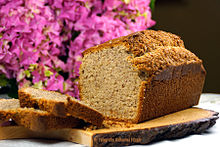Hermann dough
Hermann , also known as Glückskuchen , Glücksbrot and Vatican bread , is a sourdough made from wheat flour that contains lactic acid bacteria , yeast and a little milk, vegetable oil or water. The dough is the basis for the so-called Hermann cake , but can also be used in other baked goods. The special thing about it is that the yeast dough base increases with feeding and remains stable. This is due to the enzymatic reactions of the yeast that change the dough. A similar enzymatic reaction can be observed in kombucha .
In essence, such sourdough approaches have been known since antiquity with fermented milk and flour, possibly with the addition of honey. In German-speaking countries, the name Hermann (-Teig) has been known since the 1970s at the latest. However, nothing reliable is known about the origins of the name. Usually you get the dough from friends or acquaintances together with instructions that are summarized in a text called Hermann's letter . The origin of this custom is also unclear, but it emerged during the German peace and ecological movement around 1980 and was passed on as a chain letter .
A similar dough is known in the United States as the Amish Friendship Bread . The name Friendship Bread goes back to a sourdough bread of the Amish (English Amish ), who distributed this bread to the needy. However, the sweet cake recipe is not an Amish invention. Herman's dough tastes a little less sweet than the American version of the recipe.
Individual evidence
- ↑ Nicole Hery-Moßmann: Hermann Dough - prepare, feed and bake . focus.de. September 15, 2017. Retrieved December 15, 2019.
- ↑ Marlon Baker: Death by Chocolate . BoD - Books on Demand, 2011, ISBN 978-3-8448-1141-4 ( google.de [accessed March 27, 2020]).

